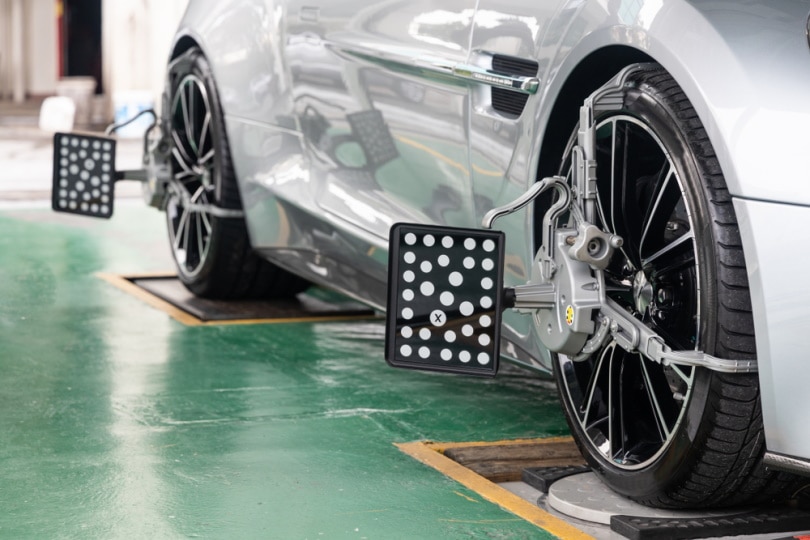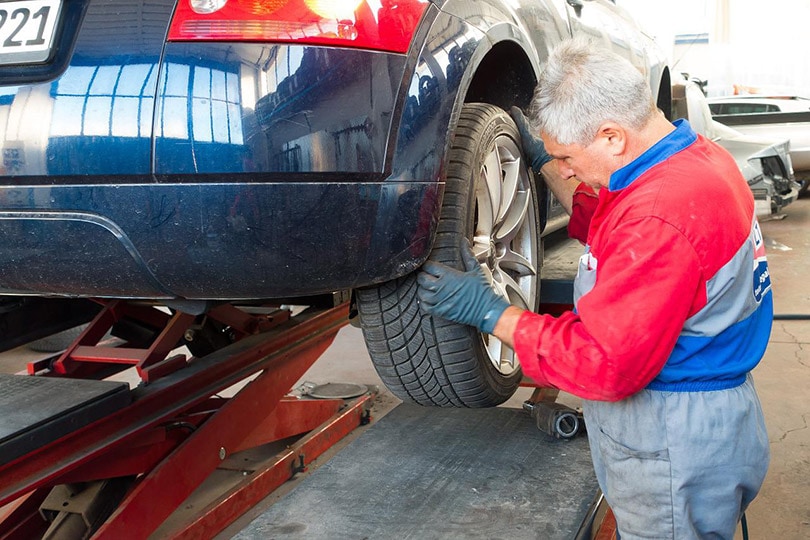What Is a Wheel Alignment? Benefits, Types & Signs
-
Visnja Radosavljevic
- Last updated:

Every vehicle needs a wheel (tire) alignment every once in a while to help your tires perform adequately and last longer. A wheel alignment will also help your vehicle be more stable and easier to handle, preventing your car from pulling in one direction.
If you’ve been thinking about getting a wheel alignment but were unsure if you need one, read through the rest of our article to learn what wheel alignment is and whether you need it for your vehicle.

How Does it Work?
Your wheels can get out of wack due to everyday driving, and when that happens, the driveability and performance of your vehicle will lower. A wheel alignment is a process where a mechanic adjusts the angle of your wheels to improve their contact and performance on the road.
Most mechanics will adjust the tires to match your manufacturer’s specifications and set the tires in an optimum position to increase efficiency and reduce wear of your tires. When you get a wheel alignment, the car’s suspension will be set to angles that allow smooth contact between your tires.

What are the Different Angles of Wheel Alignment?
There are three different angles of wheel alignment:
- Camber angle: An outward or inward tire angle when you look at the tires from the front of the vehicle. When there’s too much outward or inward tilt (positive or negative camber), that’s an indicator of wheel misalignment that needs adjustment. Worn-out suspension parts can contribute to this misalignment.
- Toe angle: This is the extent to which your tires turn outwards and inwards, but when you look at them from above. When looking from above and your tires are angled the same way, that’s a toe-in alignment, while toe-out alignment is when the tires are angled outwards. Both of these situations will require an alignment to position the wheels correctly.
- Caster angle: The caster angle helps to balance stability, cornering, and steering, and it represents the angle of your axis when you look at it from the side of your car. When the steering axis is positive, it will tilt toward the driver, while when negative, it will tilt toward your car’s front.

How Do I Know If I Need a Wheel Alignment?
There are different situations when you might need a wheel alignment. Some of the most common signs you need one are:
- You have a set of brand new tires
- You’ve replaced or adjusted your vehicle’s suspension
- You’ve had a hard impact with road debris or a curb
- You’ve noticed uneven tire wear
- You haven’t had a wheel alignment for up to a year
- You are having difficulties steering the vehicle
- Your vehicle is pulling to one side while driving
Whenever you notice one of these signs, the issue is probably in your wheel alignment. When your tires are not properly aligned, they will have a shorter lifespan. Also, when the tires are not aligned as they are supposed to, they can quickly lead to flats, loss of pressure, and accidents.
The symptoms typically show gradually, so you should always pay attention to even the most minor changes that could indicate you need a wheel alignment. To save money and effort, have these causes in mind, perform regular check-ups, and get a wheel alignment at least once a year.

Advantages of Wheel Alignment
By now, you already know that a wheel alignment is beneficial, but we wanted to point out some of the most significant advantages of getting this procedure.
Smooth ride
When your wheels are not aligned as they should be, your car can pull to one side, leading to a bumpy ride filled with vibrations. A wheel alignment will resolve this issue, and it will allow you to maneuver the vehicle better, increasing performance and providing a smoother ride while on the road.
Improved fuel efficiency
Misalignment in your wheels can increase your need for fuel. That’s because the tires drag on the road instead of rolling as they’re supposed to. When your tires are not adjusted, you’ll likely spend more money on gas. That’s why a wheel alignment can help you fill your tank less often and conserve fuel instead.

Better steering
When misalignment occurs, your car becomes harder to steer, and you might need to hold the steering wheel at a weird angle to drive your vehicle straight. Due to the lack of control, you are more prone to accidents and issues, and a wheel alignment can resolve this problem. When you get an adequate wheel alignment, your car will be easier to steer, and you’ll have more balance and control over your vehicle.
Fewer repairs
Misalignment in your tires can lead to severe issues with the vehicle, causing more damage and adding to your repair costs. Overall, you could potentially damage the whole suspension system just because of misalignment in your tires. By doing a wheel alignment, you’ll lower the chances of bigger problems, and your car will need fewer repairs.
Increased tire lifespan
Another common issue misalignment can cause is uneven wear of your tires, which will make them last less than they should. We suggest getting a wheel alignment at least every 6,000 miles to help your vehicle perform better and make your tires last longer.


Frequently Asked Questions (FAQs)
How does a wheel alignment keep you safe?
When driving a car with a wheel misalignment, your tires wear unevenly, and they can suffer from wear and tear, which could be unsafe. Since misalignment puts a lot of pressure on your suspension system, you can have issues with steering, and you will need to have a hard grip on your steering wheel.
Also, when driving at higher speeds, a misalignment can quickly lead to steering difficulties that can cause accidents and drag you to the side. Due to the malfunctions in the suspension system, your car will be using more fuel which is an additional cost you wouldn’t have if your tires were aligned adequately.

Is a wheel alignment expensive?
A wheel alignment is typically not an expensive procedure, but the price will depend on multiple factors:
- Car type: A wheel alignment for newer vehicles and luxurious cars will cost more than for older models. That’s mainly because newer models and expensive cars need specialized equipment that makes the alignment job time-consuming and more challenging.
- Number of wheels: When doing an alignment for just two wheels, the price will be lower than doing an alignment for all four wheels.
- Additional services: When you get a wheel alignment, your vehicle might need additional services such as tire balancing or suspension repairs that can add up to the final cost of the alignment.
- Labor costs: The overall wheel alignment price will also vary per your location and the local labor costs in your area.
Always be aware of signs that can indicate that your vehicle needs a wheel alignment and if you notice one of them, take your car to a mechanic. That way, you will ensure your safety while on the road while also increasing the performance level of your vehicle.
The alignment services are typically quite fast, and your wheel alignment should be done in about 1 hour, depending on your car’s circumstances. However, the procedure could take longer if there are other issues that need to be resolved before the alignment.
Overall, it’s a standard procedure every driver should practice yearly to keep their tires in shape and allow a smooth driving experience.


Conclusion
You should get a wheel alignment at least once a year, if not even more frequently, to ensure the performance of your vehicle and reduce repair costs. An alignment will help your vehicle to be better balanced and more stable, leading to a much more comfortable ride which is why you should carefully look out for any signs of misalignment.
Featured Image Credit: ThamKC, Shutterstock
Contents
